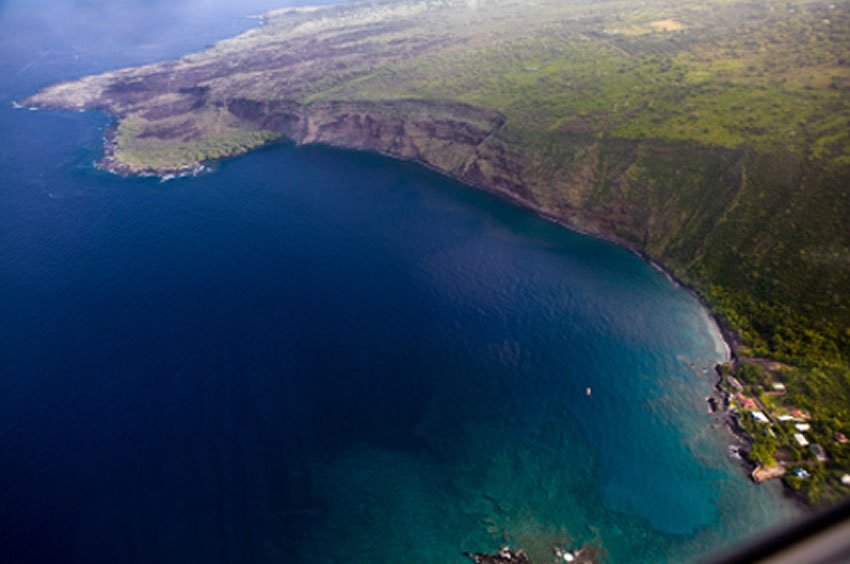Napo'opo'o Beach Park

Napo'opo'o Beach Park is a historic and scenic beach park on the Big Island's west coast at the southern end of Kealakekua Bay. This is where Captain James Cook first landed in Hawaii in 1779, and where the Hiki'au Heiau, a sacred Hawaiian temple, still stands today. With its rocky shoreline, good snorkeling during calm conditions, and picnic-friendly layout, the park offers a blend of cultural significance and natural beauty for visitors exploring Kona's rich heritage.
Napo'opo'o Beach Park, Big Island
A quaint historical charm surrounds the rugged landscape of Napo'opo'o Beach Park, a cultural gem on the Big Island's west shore, located at the southern end of Kealakekua Bay. This is where Captain James Cook first set foot on the Big Island of Hawaii on January 17, 1779, and where the first Christian service was held by his crew.
Just across the bay is the exact spot where he was killed less than a month later (today a 27-foot white obelisk is standing near the spot where he was killed, which can be seen from Napo'opo'o Beach Park). Every step on this beach is a walk through time, and every stone has a story to tell.
One of the highlights of this beach is the Hiki'au Heiau (ancient Hawaiian temple site), a temple dedicated to Lono, the god of agriculture and fertility of the land. When Cook arrived here in 1779, the natives initially thought he was Lono and that the large ships were newly formed islands. The heiau is accessible via a trail located behind the beach.
The shoreline is rocky, but walkable. What used to be a sandy beach has eroded over time. Now, mainly boulders make up the beach. Snorkeling at Napo'opo'o is good when the water is calm and clear. Like most beaches in the area, there is some interesting marine wildlife to observe, including green sea turtles. If you're lucky, you might spot some of them resting on the shore.
Napo'opo'o is also a popular spot for picnics and barbecues. There's plenty of shade in this 6-acre (24,281 sq. m) beach park, and you can find grills and tables throughout the park.
Update: The entire Napo'opo'o area were hit hard on March 11, 2011, when a tsunami (which was generated by the magnitude 9.0 earthquake in Japan) washed ashore here and caused extensive damage to many of the beach homes. One of the homes a little further south from here was lifted up and sucked out to sea.
Key Features of Napo'opo'o Beach Park
- Historic landing site: Captain James Cook first set foot here in 1779, and the bay marks a key moment in Hawaiian history.
- Hiki'au Heiau: Ancient Hawaiian temple near the beach, dedicated to Lono, the god of fertility and agriculture.
- Snorkeling and diving: Good underwater visibility and marine life during calm ocean conditions.
- Rocky shoreline: Limited sand but walkable; green sea turtles are occasionally spotted resting onshore.
- Picnic-friendly: Facilities include pavilions, BBQ grills, and shaded grassy areas for families and groups.



Also, that guy who left the last comment is a fucking asshole ;)
(He wasn't eaten, they separate bones from flesh, and they gave a bunch of them to his crew, some went apeshit and shot a bunch of Hawaiians.

Frequently Asked Questions
Where is Napo'opo'o Beach Park located?
Napo'opo'o Beach Park is located on the southern edge of Kealakekua Bay in Captain Cook, Hawaii, at the end of Napo'opo'o Road (State Hwy 160).
What is the Hiki'au Heiau?
Hiki'au Heiau is an ancient Hawaiian temple site near the shoreline, dedicated to the god Lono and still accessible via a short trail behind the beach.
Is this where Captain Cook landed?
Yes. Captain Cook arrived at this location on January 17, 1779. A white obelisk marks the place of his death across the bay, visible from the park.
Is the beach good for snorkeling?
Yes, when the water is calm. The bay offers good visibility and occasional sightings of green sea turtles and tropical fish.
Are there picnic facilities at the park?
Yes. The park has restrooms, showers, BBQ grills, a pavilion, and picnic tables under shady trees.















